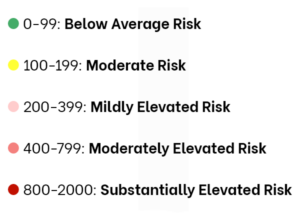 Crime isn’t static and neither are the factors impacting crime. Crime responds to societal changes, with new trends continuously emerging that can put your business at risk. To assess and accurately predict these risks, we update our database every year with the most recent data available, analyzing over 200 million data points from more than 240,000 US block groups (a proxy for neighborhoods). This year, our database includes crime risk data for 8 million businesses — and nearly 70% of those locations saw a change in their CAP Index crime risk category from our last release.
Crime isn’t static and neither are the factors impacting crime. Crime responds to societal changes, with new trends continuously emerging that can put your business at risk. To assess and accurately predict these risks, we update our database every year with the most recent data available, analyzing over 200 million data points from more than 240,000 US block groups (a proxy for neighborhoods). This year, our database includes crime risk data for 8 million businesses — and nearly 70% of those locations saw a change in their CAP Index crime risk category from our last release.
The expert criminologists at CAP Index identified several points of consideration that are affecting changes in crime risk. These factors play a role in both how crime itself is evolving and how agencies can analyze crime trends.

We have all heard how the COVID-19 pandemic was a major catalyst for recent shifts in crime patterns, as everyone’s routines experienced a dramatic transformation. As we further distance ourselves from 2020, many of the COVID-era norms and behaviors are finally starting to settle back into pre-pandemic patterns (though not all — work from home seems to be here to stay in many industries).
This return is reflected in the crime data we are seeing now. While violent crime shot up during the pandemic, we are starting to see a reduction in these incidents. As more data from 2023 are released, we expect a continuing decrease in violence from 2022.
This is a positive sign for the country, but it’s important to note that national crime patterns like these can differ when looking at them from a local level. Depending on the city, site, or industry, businesses may experience these crime trends very differently. ** Read our “Ask the Expert” on this topic!

There’s no question the landscape of policing has changed in recent years. The backlash against police forces has led to a reduction in police staff — from increases in sworn personnel retiring and resigning to difficulty recruiting and hiring new officers. While 2020’s massive hiring dip is slowly rebounding, many agencies are struggling to return to full staffing. This has resulted in jurisdictions enticing recruits with sign-on or training completion bonuses, or are sweetening the deal for current officers with pay increases.
These policing shortages can affect crime and crime data in multiple ways. For instance, Dallas has prioritized their response to violent crimes over other types of crime calls. This leaves lower priority crimes to be handled in different manners, such that in 2023, Dallas mandated non-violent, non-emergency crimes be reported through an online form. These include many common property crimes (e.g., burglary of motor vehicles, theft, graffiti) and financial crimes (identity theft and credit/debit card). Dallas PD goes even further to providing instructions for shoplifting case filing for retail/businesses to follow. The changes in crime reporting could lead to further underreporting issues in policing data.

In 2021, crime data collection by the FBI moved from the commonly known UCR Summary Reporting System (SRS) to the National Incident Based Reporting System (NIBRS).
While the increased requirements and data fields needed for NIBRS reporting provide richer data for analysis, law enforcement agencies are having difficulty keeping up with the requirements needed to report to the FBI.
NIBRS data are voluntarily submitted, which led to many law enforcement agencies not reporting NIBRS in 2021. There has been a continual concerted effort to assist agencies in their move to newer records management systems that accommodate NIBRS requirements – including federal funding. There are still gaps in data coverage with certain states lagging behind others in their adoption of NIBRS. National crime estimates have been impacted by the change in data collection through the FBI. This will take years to see similar reporting by agencies as seen under SRS.
Predictions for 2024
While recent data indicate crime has been low to start the year, we see it as the calm before the storm. Summer typically experiences the highest number of incidents, so we’re likely heading into a period of increased crime (i.e., seasonality of crime). The upcoming election has security professionals on high alert, too. As we get closer to November, crime may be impacted, including the possibility of protests.
Beyond National Trends
Though we can gain an understanding of how crime is changing by taking a nationwide look, when you dig deeper, the trends don’t always hold true at a local level. But consulting only your local police data doesn’t work either, since inconsistencies in reporting can make it difficult to assess what information is relevant to you. For a more accurate prediction of your business’s crime risk, you need to go a step further.
CAP Index CRIMECAST Data and Reports are built on more than just police data. Our proprietary, best-in-class scoring system employs advanced forecasting techniques that merge historical crime and loss data with demographic and business statistics to accurately assess crime risk at a local level. Empowered by relevant, objective data, you can confidently make key security decisions to better protect your people and locations.
Contact CAP Index now to discuss how CRIMECAST Data can help your business.
Get in Touch Now
Our experts can answer your questions.
Latest Posts

CAP Reports are critical to my risk assessments. They have enabled us to take a more surgical approach to investing in our stores that need it the most.
Brad Reeves
Senior Manager of Asset Protection
Five Below, Inc.

CAP Index is the first tool I turn to when time is of the essence. I can always depend on CAP Index to provide me qualified crime information within a very few minutes that I feel comfortable reviewing with the C-Suite.
Stephen A. Brown, CPP
Director, Corporate Security / Facility Security Officer
Burns & McDonnell

CAP Index data is a vital part of our security decision-making process.
Keith McGlen, CPP, CHPA
Associate Vice President
System Security Services
Memorial Hermann Health System

CRIMECAST® Reports have helped our organization for many years to proactively assess the particular risk for crime surrounding our facilities. The CAP Index® CRIMECSAST Platform is an easy-to-use online service that provides us with the flexibility to share and decentralize crime risk data within our North America business units.
Carlos J. Cortez,
Manager, Global Security Programs,
Kraft Foods, Inc. / Mondelez International

Our property selectors are not discouraged from a site just because it receives a high score. What we do is issue every store – all of them – a security classification. The classification determines how we allocate our security resources to that store.
Claude Verville,
Lowe’s

CAP Index's online platform, CRIMECAST, is great. It is easy to use and quick!
Ken Wieczorek,
Bank of America

In industries where there is high public contact and a customer is coming to our location (such as retail), why would you leave it to chance when planning security when there is an easy, affordable tool? When investing a million dollars on a location, what is this small charge compared to what it may cost you when you get sued?
Jay Beighley,
Nationwide Insurance

CAP Index assessments are a must for anyone engaged in asset protection. The new website is much improved and as important, easy to navigate.
Bruce List,
The Williams Companies

We have been using CAP Index for a few years and include it in our security vulnerability assessments. Highly recommend it.
Dan Yaross
Director, Protective Services
Nationwide Children's Hospital
 Sample CRIMECAST Reports
Sample CRIMECAST Reports